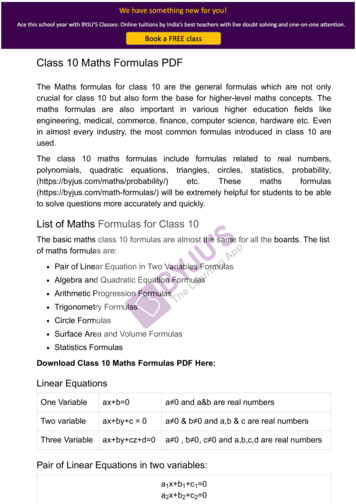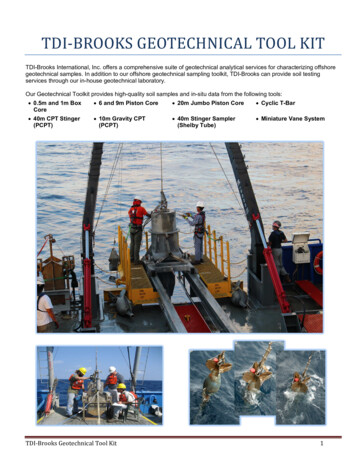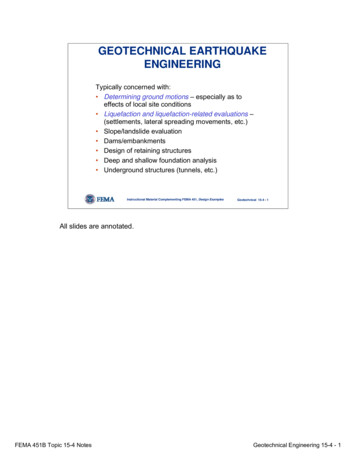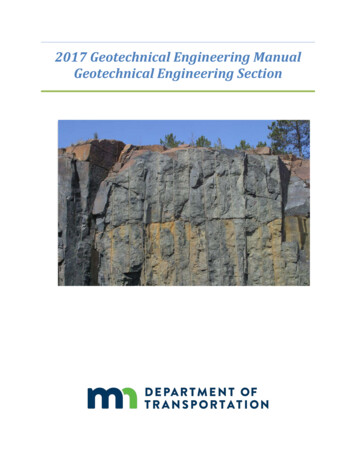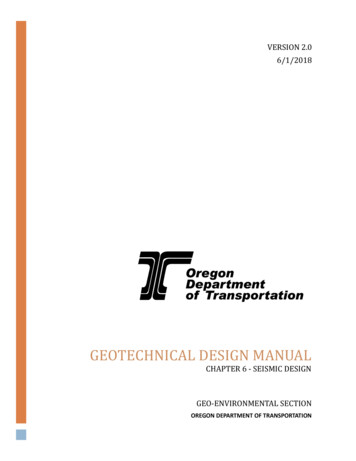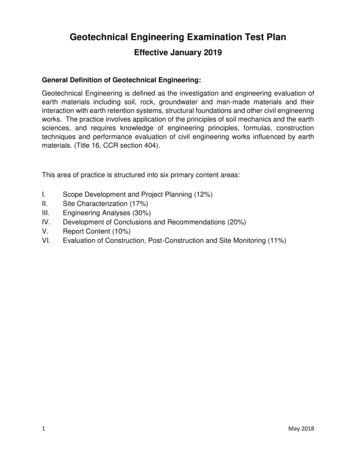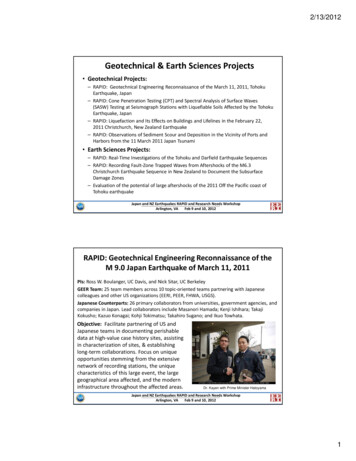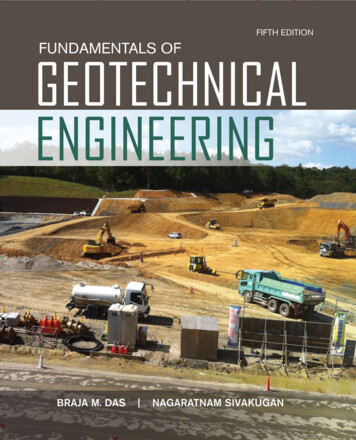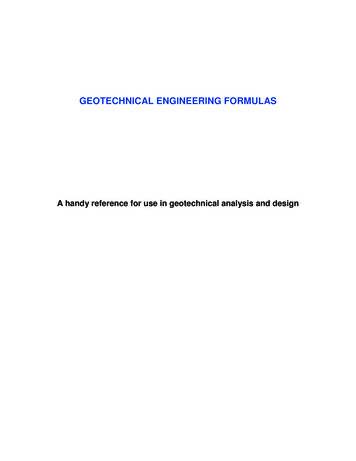
Transcription
GEOTECHNICAL ENGINEERING FORMULASA handy reference for use in geotechnical analysis and design
TABLE OF CONTENTSPage1.SOIL CLASSIFICATION .31.1USCS: Unified Soil Classification System.31.1.1Relative Density of Cohesionless Soils: .41.1.2Fine Grained(Cohesive) Soil Charts using the USCS System:.41.1.3Consistency of Fine Grained Soils: .51.2USDA Soil Classification System .51.3AASHTO Soil Classification System:.62. PHASE RELATIONSHIP EQUATIONS: .72.1Shear Strength of Soils .72.2Bearing Capacity of Soils .73. STRESSES IN SOILS .93.1Various Loading Conditions:.9.9.94. SHALLOW FOUNDATIONS .104.1Conventional Footings.104.11Geotechnical Analysis.104.12 Structural Design:.104.2 Strap or Cantilever Footings: .114.3 Trapezoidal Footings: .125. SOIL CONSOLIDATION EQUATIONS .145.1Instant Settlement of footings:.145.2Primary Consolidation: .145.3 Overconsolidated Soils .145.4 Time rate of settlement .155.41 Coefficient of consolidation.156. RETAINING STRUCTURES: .166.1 Horizontal Stresses: Active, At Rest and Passive.166.2 Basement Wall with surcharge: .176.3 Braced Excavations: .176.4 Forces on Struts:.186.5 Cantilever Sheetpiles in Sand .206.6 Cantilever Sheetpiles in Clay .216.6 Anchored Sheetpiles in Sand (Also called Bulkheads) .226.7 Anchored Sheetpiles in Clay (Also called Bulkheads).247. PILE FOUNDATIONS .258. Post Tensioned Slabs: .289. Asphalt Mix Design: .3010.Concrete Mix Design:.33
1.1.1SOIL CLASSIFICATIONUSCS: Unified Soil Classification SystemCoarse Grained soils have less than 50% passing the # 200 sieve:SymbolPassingthe #200DDCu Soil DescriptionCc 60(D30D1030)2 D60GW 5%4 or higher1 to 3Well graded gravelGP 5%Less than 41 to 3Poorly graded gravelGW-GM5 to12%4 or higher1 to 3 but with 15% sandWell graded gravel withsiltGW-GM5 to12%4 or higher1 to 3 but with 15% sandWell graded gravel withsilt and sandGW-GC5 to12%4 or higher1 to 3 but with 15% sandWell graded gravel withclay or silty clayGW-GC5 to12%4 or higher1 to 3 but with 15% sandWell graded gravel withclay and sandGC 12%N/AN/A, 15%sandClayey GravelGC 12%N/AN/A, 15%sandClayey Gravel with sandGM-GC 12%N/AN/A, 15%sandClayey Silt with gravelGM-GC 12%N/AN/A, 15%sandClayey Silt with sandSW 5%6 or higher1 to 3Well graded sandSP 5%Less than 61 to 3Poorly graded sandSM 12%N/AN/ASilty Sand or Sandy SiltSC 12%N/AN/AClayey Sand or SandyClaySC-SM 12%N/AN/ASilty Clay with SandWhere:Cu Uniformity Coefficient; gives the range of grain sizes in a given sample. Higher Cu means well graded.Cz Coefficient of Curvature is a measure of the smoothness of the gradation curve. Usually less than 3.D10, D3, & D60 are the grain size diameter corresponding to 10%, 30% and 60% passing screen.
1.1.1 Relative Density of Cohesionless Soils:SPT or N valueRelative Density% Relative Density0–3Very loose0 – 154 – 10Loose15 – 3511 – 30Medium dense35 – 6531 – 50Dense65 -85 50Very dense85 - 1001.1.2 Fine Grained(Cohesive) Soil Charts using the USCS System:
1.1.3 Consistency of Fine Grained Soils:SPT or N valueCohesion, C or SuConsistency 2 500 psfVery soft2–4500 – 1000 psfSoft5–81000 – 2000 psfFirm9 – 152000 – 4000 psfStiff16-304000 – 8000 psfVery stiff 30 8000 psfHard1.2USDA Soil Classification SystemThe percent SAND,SILT,and CLAY lines are drawn and their intersection gives thesoil classification.
1.3AASHTO Soil Classification System:CLASSIFICATION OF HIGHWAY SUBGRADE MATERIALS(With suggested subgroups)General ClassificationSilt-Clay Materials (More than 35%passing #200)Granular Materials (35% or less passing No. 200)A-1A-2Group 50-3536-10036-10036-10036-1000-400-1041 0-100-4011 41 11 0-400-100-841 0-100-120-4011 0-1641 11 0-20Sieve Analysis,Percent Passing:No. 10No. 40No. 20051-1000-10Characteristics offraction passing # 40:Liquid LimitPlasticity IndexGroup IndexUsual Types ofSignificicant ConstituentMaterialsGeneral Rating asSubgrade0-60N.P.0Stone Fragments,Gravel and SandFineSandExcellent to Good00-4Silty or Clayey Gravel and SandSilty SoilsFair to PoorCohesive soils classification in AASHTO System:Clayey Soils
2.PHASE RELATIONSHIP EQUATIONS:Dry UnitWeight, ȖdBulk or Wet or TotalUnit Weight, Ȗm orȖw or Ȗt or Ȗ2.1Shear Strength of Soils2.2Bearing Capacity of SoilsHansen B.C. Factors:Saturated UnitWeight, Ȗs or Ȗsat
Terzaghi B.C. Factors
Note:If Df/B 1, terzaghi’s B.C. factors do not apply. Use Hansen’s B.C. factors.For example, if depth of footing (Df) is 3 ft but footing width (B) is 2.75 ft.3.3.1STRESSES IN SOILSVarious Loading Conditions:Strip
4.SHALLOW FOUNDATIONSQ4.1 Conventional Footings4.11Geotechnical Analysisqall Q / Bx1 for Continuous Footingsqall Q / BxL for Rectangular Footingsqall Q / BxB for Square Footingsqall qu / 3 from Bearing Capacity Calculationse B/6, where e eccentricityDf 1.0 ft minimumDf frost depthDf setback distance for footings on slopeDf scour depthDf high moisture variations depth(expansive soils)Dfq allBLayer 11B12Layer 2CcC 1 Eo2BLayer 3GWT3B4.12 Structural Design:Given: A Continuous footing with Ȗm 100 pcf, Df 5 ft, qall 4,000 psf, D.L 22 k/ft,L.L. 12 k/ft, f’c 3 ksi, fy 60 ksi. Design the footings using the ACI code:
4.2 Strap or Cantilever Footings:Strap Footing with varying beam thicknessStrap Footings with constant beam thickness
4.3 Trapezoidal Footings:
5.5.1SOIL CONSOLIDATION EQUATIONSInstant Settlement of footings:or5.2Primary Consolidation:or5.3 Overconsolidated Soilsoror
5.4 Time rate of settlement (i immediate, c consolidation, & s secondary)5.41 Coefficient of consolidation, Cv:
6.RETAINING STRUCTURES:6.1 Horizontal Stresses: Active, At Rest and Passive
6.2 Basement Wall with surcharge:6.3 Braced Excavations:
6.4 Forces on Struts:
Bottom Heave Calculations:
6.5 Cantilever Sheetpiles in Sand
6.6 Cantilever Sheetpiles in Clay
6.6 Anchored Sheetpiles in Sand (Also called Bulkheads)
6.7 Anchored Sheetpiles in Clay (Also called Bulkheads)
7.PILE FOUNDATIONS7.1 Single Piles Equations:
7.2 Group capacity of piles:Example:
7.3 Settlement of Group Piles:8.Edge Lift:Post Tensioned Slabs:
Center Lift:The Structural Engineer also needs Kv (given in immediate settlement section), effective PI(pp138 of Geotechnical DVD book) and other climatic constants that are from building codes(given).
9.Asphalt Mix Design:
AC Mix design Formulas:
When weighing in Water:When weighing in Air:Open Graded Mixtures:
10. Concrete Mix Design:Fineness modulus:
Yield:Relative Yield:Modulus of Rupture: (7.5 f’c) or
GEOTECHNICAL ENGINEERING FORMULAS A handy reference for use in geotechnical analysis and design . TABLE OF CONTENTS Page . 4.12 Structural Design: Given: A Continuous footing with m 100 pcf, Df 5 ft, qall 4,000 psf, D.L 22 k/ft, . geotechformulas.pdf
